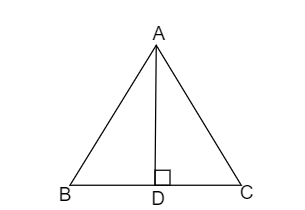
An equilateral triangle has an altitude of \[15\]m. What is the perimeter of the triangle?
Answer
427.8k+ views
Hint: We will use the concepts in geometry such as triangles and their properties to solve the given problem.
We will define different types of triangles and their properties by illustrating them. We will use Pythagoras theorem too while solving this problem.
In mathematics, a triangle is a polygon (a closed figure) with three sides.
Equilateral triangle – A triangle with all sides equal.

In a triangle, a perpendicular drawn from a point to the side opposite to that point is called the altitude of a triangle.

Here, the line \[{\text{AD}}\] is called the altitude.
In an equilateral triangle, all sides are equal and that implies that all angles are equal to \[{60^ \circ }\].
Complete step by step solution:
Consider the figure.

Let the side of an equilateral triangle be ‘\[a\]’.
From the triangle, \[\vartriangle ACD\].
By applying Pythagoras theorem in \[\vartriangle ACD\], we get, \[A{D^2} + D{C^2} = A{C^2}\]
\[ \Rightarrow {h^2} + {\left( {\dfrac{a}{2}} \right)^2} = {a^2}\]
\[ \Rightarrow {h^2} = {a^2} - \dfrac{{{a^2}}}{4} = \dfrac{{3{a^2}}}{4}\]
So, we get, \[h = \dfrac{{a\sqrt 3 }}{2}\]
And this is the relation between altitude of an equilateral triangle and the side of an equilateral triangle.
So, now, it is given that, the altitude of an equilateral triangle is \[15{\text{ m}}\].
Substituting this in the above relation, we get,
\[ \Rightarrow 15 = \dfrac{{a\sqrt 3 }}{2}\]
\[ \Rightarrow a = \dfrac{{30}}{{\sqrt 3 }} = \dfrac{{3 \times 10}}{{\sqrt 3 }} = 10\sqrt 3 \]
So, side of this equilateral triangle is \[10\sqrt 3 {\text{ m}}\].
And we all know that, perimeter of an equilateral triangle of length \[a\] is \[3a\] units.
Therefore, the perimeter of this equilateral triangle is \[3 \times 10\sqrt 3 = 30\sqrt 3 {\text{ m}}\].
Note:
Other two types of triangles based on lengths of sides are:
(1) Scalene triangle – A triangle with all three sides of different lengths.

(2) Isosceles triangle – A triangle with two sides equal.

> We found the relation between altitude and side by applying Pythagoras theorem. But instead, we can also do it in another way.
In triangle \[\vartriangle ACD\], take the tangent ratio of angle C.
\[ \Rightarrow \tan C = \dfrac{{AD}}{{DC}} = \dfrac{h}{{\dfrac{a}{2}}} = \dfrac{{2h}}{a}\]
And we know that all angles of an equilateral triangle are \[{60^ \circ }\]. So, \[C = {60^ \circ }\]
\[ \Rightarrow \tan {60^ \circ } = \dfrac{{2h}}{a}\]
And we know that, \[\tan {60^ \circ } = \sqrt 3 \].
\[ \Rightarrow \sqrt 3 = \dfrac{{2h}}{a}\]
\[ \Rightarrow h = \dfrac{{\sqrt 3 }}{2}a\]
And using this, we can solve our required problem.
We will define different types of triangles and their properties by illustrating them. We will use Pythagoras theorem too while solving this problem.
In mathematics, a triangle is a polygon (a closed figure) with three sides.
Equilateral triangle – A triangle with all sides equal.

In a triangle, a perpendicular drawn from a point to the side opposite to that point is called the altitude of a triangle.

Here, the line \[{\text{AD}}\] is called the altitude.
In an equilateral triangle, all sides are equal and that implies that all angles are equal to \[{60^ \circ }\].
Complete step by step solution:
Consider the figure.

Let the side of an equilateral triangle be ‘\[a\]’.
From the triangle, \[\vartriangle ACD\].
By applying Pythagoras theorem in \[\vartriangle ACD\], we get, \[A{D^2} + D{C^2} = A{C^2}\]
\[ \Rightarrow {h^2} + {\left( {\dfrac{a}{2}} \right)^2} = {a^2}\]
\[ \Rightarrow {h^2} = {a^2} - \dfrac{{{a^2}}}{4} = \dfrac{{3{a^2}}}{4}\]
So, we get, \[h = \dfrac{{a\sqrt 3 }}{2}\]
And this is the relation between altitude of an equilateral triangle and the side of an equilateral triangle.
So, now, it is given that, the altitude of an equilateral triangle is \[15{\text{ m}}\].
Substituting this in the above relation, we get,
\[ \Rightarrow 15 = \dfrac{{a\sqrt 3 }}{2}\]
\[ \Rightarrow a = \dfrac{{30}}{{\sqrt 3 }} = \dfrac{{3 \times 10}}{{\sqrt 3 }} = 10\sqrt 3 \]
So, side of this equilateral triangle is \[10\sqrt 3 {\text{ m}}\].
And we all know that, perimeter of an equilateral triangle of length \[a\] is \[3a\] units.
Therefore, the perimeter of this equilateral triangle is \[3 \times 10\sqrt 3 = 30\sqrt 3 {\text{ m}}\].
Note:
Other two types of triangles based on lengths of sides are:
(1) Scalene triangle – A triangle with all three sides of different lengths.

(2) Isosceles triangle – A triangle with two sides equal.

> We found the relation between altitude and side by applying Pythagoras theorem. But instead, we can also do it in another way.
In triangle \[\vartriangle ACD\], take the tangent ratio of angle C.
\[ \Rightarrow \tan C = \dfrac{{AD}}{{DC}} = \dfrac{h}{{\dfrac{a}{2}}} = \dfrac{{2h}}{a}\]
And we know that all angles of an equilateral triangle are \[{60^ \circ }\]. So, \[C = {60^ \circ }\]
\[ \Rightarrow \tan {60^ \circ } = \dfrac{{2h}}{a}\]
And we know that, \[\tan {60^ \circ } = \sqrt 3 \].
\[ \Rightarrow \sqrt 3 = \dfrac{{2h}}{a}\]
\[ \Rightarrow h = \dfrac{{\sqrt 3 }}{2}a\]
And using this, we can solve our required problem.
Recently Updated Pages
Master Class 11 Economics: Engaging Questions & Answers for Success

Master Class 11 Accountancy: Engaging Questions & Answers for Success

Master Class 11 English: Engaging Questions & Answers for Success

Master Class 11 Social Science: Engaging Questions & Answers for Success

Master Class 11 Biology: Engaging Questions & Answers for Success

Master Class 11 Physics: Engaging Questions & Answers for Success

Trending doubts
Difference Between Plant Cell and Animal Cell

Name 10 Living and Non living things class 9 biology CBSE

Fill the blanks with the suitable prepositions 1 The class 9 english CBSE

On an outline map of India show its neighbouring c class 9 social science CBSE

The highest mountain peak in India is A Kanchenjunga class 9 social science CBSE

How many faces edges vertices are there in the following class 9 maths CBSE




